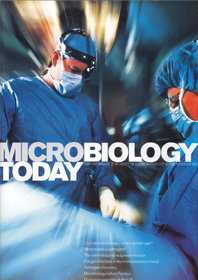Clinical Microbiology
01 February 2001 publication
The lead articles of the February 2001 issue of Microbiology Today are on clinical microbiology - a new golden age?; what makes a pathogen?; the rise in hospital-acquired infection; fungal infections in the immunocompromised; pathogen discovery; microbiology before Pasteur; and protozoan parasites in the UK.
Clinical microbiology - a new golden age? (p. 03)
Clinical microbiology has never been more important and the SGM has formed a new Group to cater for the needs of practitioners and researchers. Stephen Gillespie, Convener of the Group, describes the current state of clinical microbiology in the context of the history of science.
What makes a pathogen? (p. 04)
Large numbers of micro-organisms inhabit the human body. In most cases our normal flora is beneficial or harmless. Tony Hart and Craig Winstanley explore why some microbes are pathogenic.
The enemy within – hospital-acquired, antibiotic-resistant bacteria (p. 07)
The battle against the rise of hospital-acquired infections caused by antibiotic-resistance micro-organisms is one of the major challenges faced by microbiologists today. Peter Hawkey takes a look at the problem and discusses how it may be tackled in the future.
Fungal infections in the immunocompromised (p. 10)
The number of severely immunocompromised patients is rising. This is leading to new problems with fungal infections, as Marc Mendelson describes.
The use of molecular techniques to detect antimicrobial resistance in clinical bacterial isolates (p. 14)
The broad range of current PCR and DNA chip applications in clinical microbiology includes the detection of pathogens and the analysis of genomic alterations, such as sequence and copy number alterations in bacterial genes and single nuleotide polymorphisms. Ad Fluit and Franz-Josef Schmitz discuss the possible application of modern molecular methods for the detection of bacterial resistance genes and mechanisms.
How technology drives pathogen discovery (p. 16)
Innovations in technology have enabled scientists to advance their knowledge of micro-organisms. Paul Kellam and Robin Weiss explain how modern molecular techniques are being used to identify previously unknown pathogens.
Microbiology before Pasteur (p. 19)
Milton Wainwright takes a look at some of the microbiological discoveries made before Pasteur's seminal studies on fermentation.
Protozoan parasites in the UK – cause for concern? (p. 22)
A range of protozoan parasites threatens the health of UK inhabitants. As Tim McHugh describes, the risks are increasing, due to a variety of factors, but measures are available to control the problem.
Going public (p. 28)
Mike Milner writes the Public Understanding of Science Award Report.
Gradline (p. 31)
The Society speaks to Rebecca Bowden, Senior Manager Science Policy at The Royal Society, about jobs in science policy.
Comment - was the BSE inquiry worth it? (p. 48)
The Rt. Hon Tam Dalyell voices his view about the BSE inquiry.

